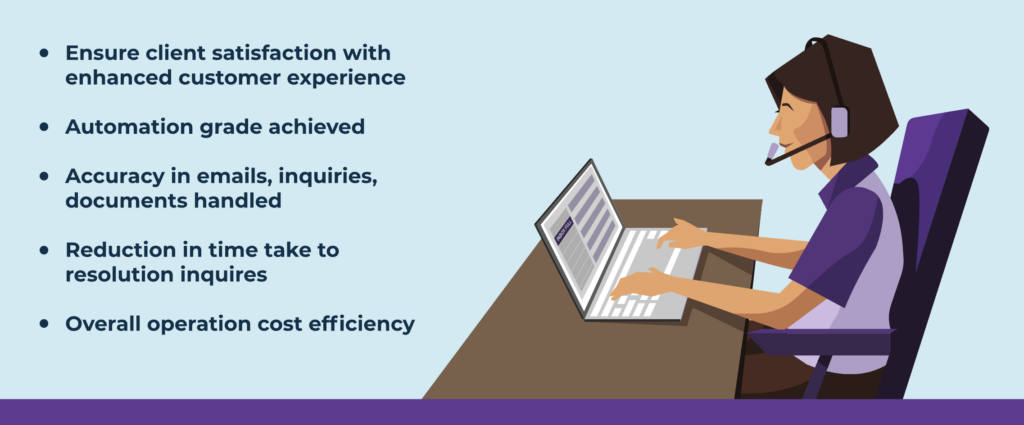How to build an AI-based Ecosystem for business process automation
It becomes imperative to understand key aspects of building an AI-based ecosystem for businesses that have either taken the decision to adopt it or already have and require further support. This blog discusses some of these areas that companies should be aware of before building an AI-based ecosystem for business automation.

Introduction – The need for an AI-based Ecosystem
AI has gradually emerged as a strong technology used in different businesses to enhance daily work operations. As Artificial Intelligence evolved over the past few decades, its scope of operations also expanded, thus making this technology viable for introduction in diverse work areas in businesses. This vast scope of AI may require organizations to set up an effective AI ecosystem. A good AI ecosystem is often critical to bringing success to a business, and if properly used, can derive huge Returns on Investment in a short time.
It becomes imperative to understand key aspects of building an AI-based ecosystem for businesses that have either taken the decision to adopt it or already have and require further support. This blog discusses some of these areas that companies should be aware of before building an AI-based ecosystem for business automation.
Understanding requirements for AI-based business process automation
Understanding the business requirement is the first step toward building an AI ecosystem. Based on these requirements the AI Ecosystem’s functions are determined. Forming a business requirement starts with identifying a business problem or a pain point that is largely affecting the quality of work, efficiency, cost, and business value.
For example, a few basic business problems arising from the conventional, manual way of operations could be –
- The lack of sufficient manpower to process daily customer inquiries leads to piling work.
- Lack of capacity among employees to handle large volumes of emails and documents in a short time.
- Human error-prone actions with less accuracy.
- Less time is available to deal with sensitive tasks that require considerable manual intervention.
Various functions that can be automated via Intelligent Process Automation (IPA)
- Customer service requests from front-end customer support, ticket resolution created by customer inquiries, 24/7 email and chat-based communication with customers.
- Actions involving replying to and forwarding emails and documents to relevant stakeholders.
- Customers applying for different services such as bank accounts, credit cards, loans, etc.
- Bills, invoices, and related paperwork, debt collection activities.
- Insurance claims and notices, policies, and other similar documents.
- Storage and archival of documents and emails in bulk containing information about a region’s citizens and their welfare. Health records, public records, and details about local governing bodies.
These activities are common in different industries such as Banking, Financial Services, Insurance, Public Sector, E-Commerce, Telecom, and Logistics.
Technical aspects for AI-based ecosystem requirements
- Infrastructure needed

External systems such as email systems, CRM systems, case management systems, and document archival systems are key infrastructure requirements in terms of setting up an AI-based ecosystem. These systems need to be capable of being integrated with AI products and solutions provided by an AI vendor with the help of API or RPA integration. In most cases, the AI solutions are pre-configured, and this is preferred due to their ease of use and implementation.
Furthermore, the infrastructure preferably requires a cloud-based server with storage capabilities, which is linked with the operation management systems.
These infrastructure requirements can be satisfied through no-code automation platforms, which have enabled businesses to use pre-configured AI solutions. They can set business rules and decisions, train the solution to take specific actions, and monitor the AI product’s performance. Businesses can plug-&-play with these platforms, which come with features such as drag & drop, reusability of AI modules, and other out-of-the-box functions. These platforms also provide other features such as Customer Dashboards for tracking, monitoring, and performance analyses.
- Training

The right kind of training is essential for deploying, maintaining, and running an AI product. The training process also includes getting the businesses familiarized with no-code automation and its platforms. The AI automation solution company chosen provides employee training programs that cover processes such as configuration, making the AI live, and other post-deployment activities.
- Customer Success

Many AI and automation vendors provide customer success and customer support as a service to organizations post-implementation. The customer success team often takes care of initiating discussions with the client businesses about the overall performance of the AI solution and gathering information post-deployment. It resolves technical difficulties for the client, tackles issues that might arise due to changing infrastructure, and carries out discussions for the same.
It is crucial for businesses to receive quality customer support from AI vendors for maintaining and monitoring AI solutions after they have been deployed. Holding periodical and annual meetings for long-term benefits by the customer success team generates insights over the long term. These insights can be used in the different strategies developed to enhance the overall performance and delivery outcomes, streamlined work operations, and happy employees.
Parameters of success
For an AI Ecosystem, it is important to determine how successful it has been for a business. This is crucial as a successful ecosystem will determine how well Artificial Intelligence is helping a business witness an improvement in its operation, generate business value, and ultimately contribute towards better customer satisfaction.
The key parameters of success in terms of building an AI-based ecosystem are:

These are just a few examples of parameters of success. These may vary for each business.
Conclusion
Building the right kind of AI ecosystem is important to derive a healthy ROI in a business. Adopting AI in a business is not a one-time process but a continuous process with regular maintenance and monitoring to ensure optimal performance.
In this blog, we saw several work areas such as infrastructure needed, training, customer success, and parameters to identify how building an AI ecosystem can be successful. A robust AI ecosystem can enable businesses to incorporate end-to-end automation in their work processes which can lead to massive improvements in overall business efficiency.
About Simplifai
Simplifai is an AI solutions company that helps businesses build powerful AI Ecosystems in their work environment. Simplifai has vast experience in setting up and managing AI ecosystems for businesses. With our AI products and solutions, we can automate your daily, repetitive processes, and cut down the time and effort taken to process large volumes of emails, documents, customer inquiries, and other similar processes.
We offer Intelligent Process Automation (IPA) that is quick to implement, affordable and does not require any technical skills. Our IPA services help businesses increase work productivity, make employees happy, and improve customer satisfaction.
To know more about how our products work, click on the following button:


